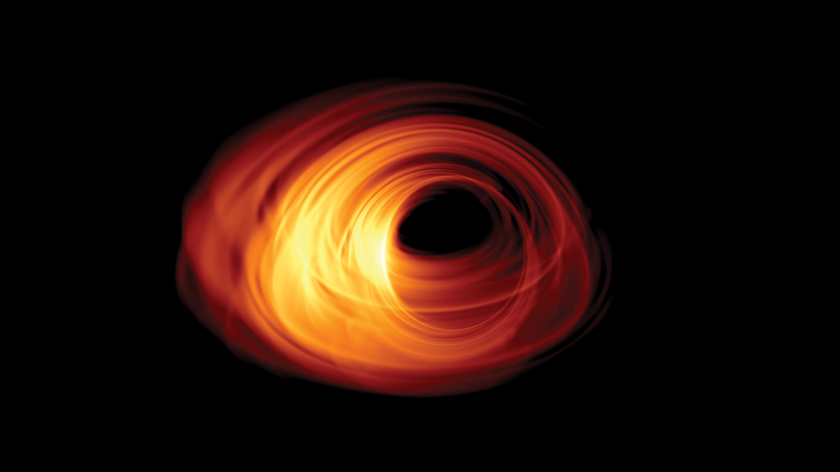New theory connects extremes of physics
-
 Simulation of the radio waves emitted by the black hole. Image: T. Bronzwaer, J. Davelaar, M. Moscibrodzka, and H. Falcke
Simulation of the radio waves emitted by the black hole. Image: T. Bronzwaer, J. Davelaar, M. Moscibrodzka, and H. Falcke
Gravity and quantum mechanics are among the giants in physics and clash quite severely at the theoretical level. Until recently, it was only possible to get them to agree through string theory, which is notoriously difficult to prove. Physicists in Nijmegen have discovered that it might be possible through a different approach, although some people still need convincing.
For people who enjoy clarity, physics seems to be the ideal field. Ranging from subatomic particles to supermassive black holes, everything in physics can be explained. However, there is a problem that has kept physicists puzzled for decades: the theory of the very small (quantum mechanics) does not play well with the theory of the very large (Einstein’s theory of general relativity). It’s like trying to mix oil and water, which is impossible as well unless one uses special agents like emulsifiers.
Vibrating strings
Thankfully, physicists have been on the trail of such an emulsifier since the 1970s: string theory. This theory can handle the explanation of phenomena at both the quantum scale and at the cosmic scale. It describes the particles that make up our world as being a kind of vibrating strings.
But there appears to be a different way to create an emulsion, as was discovered by physicists led by Frank Saueressig at the Institute of Mathematics, Astrophysics and Particle Physics. They published on this subject earlier this week in the journal Physical Review Letters and on an Open Access website for physics research.
The theory could be an alternative for string theory
Saueressig and his colleagues are tackling the mixing problem from a different angle than string theory. Whereas the latter builds upon the laws of relativity, the new theory originates from quantum mechanics. This was always tricky, Saueressig explains over the phone. ‘At the microscale, that theory works just fine, but as soon as larger amounts of energy or gravity are involved, it goes horribly wrong.’
It is therefore difficult to explain certain experiments, such as those carried out at the LHC particle accelerator at CERN, near Geneva. The researchers at CERN make particles collide and then try to explain the debris created by the collision. Saueressig: ‘It’s like throwing two Lego structures at each other and analysing the chunks and blocks that remain.’
Derailment
Predicting the influence of gravity on that debris is possible through quantum mechanics after all, as Saueressig and his colleagues demonstrate in their publication, and without the need for string theory. Using mathematical methods, they managed to ‘tame’ the derailment of the quantum theory at high energies. ‘The research field has been working toward this with great momentum over the past few years. During the first wave of COVID-19 earlier this year, we had the time to thoroughly elaborate the idea.’
The discovery does not mean that string theory has been dismissed, the physicist emphasises. The article neither confirms nor refutes it. ‘We only present an alternative.’
Inverted cause and effect relations
However, it is a very welcome alternative. Physicists have been rather upset with the bizarre predictions of string theory, like vibrations in many more dimensions than just three or four, or cause and effect relations that could get inverted. Until now, it has proven very difficult to come up with experiments to test these aspects, let alone prove the theory.
According to Saueressig, his theory will probably be much easier to test experimentally. ‘Especially with regards to matters involving gravity, like gravitational waves and black holes.’ In the next few years, he will set up experiments with the group of astronomer Heino Falcke, among others.
Sceptical
Erik Verlinde, Amsterdam-based professor of theoretical physics, expressed being sceptical about the applicability of the theory on phenomena at the cosmic scale when asked over the phone. The expert in the field of string theory, who was not involved in the research, does not yet see how the group will describe black holes from a quantum mechanics approach, for example. ‘The new theory simply lacks the necessary ingredients to achieve that. This is something that string theory does provide.’
He thinks the publication absolutely is ‘interesting and great work,’ but not a fully fledged alternative for string theory. It can be used on the micro scale, though. ‘Describing colliding gravitons (a kind of gravitational particles, ed.), which still need to be demonstrated for that matter, could indeed be done very nicely without using string theory. This is something people have been working on since the 1970s.’
This means we will need to wait to see whether a new emulsifier can truly be added to the physics kitchen.




